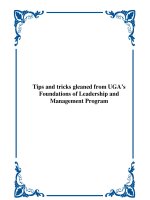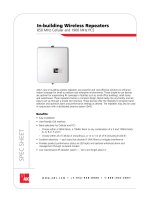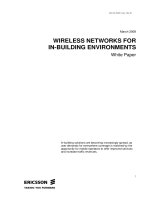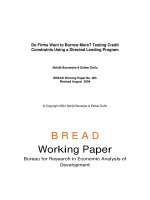Building multitiers program doc
Bạn đang xem bản rút gọn của tài liệu. Xem và tải ngay bản đầy đủ của tài liệu tại đây (284.45 KB, 17 trang )
Building multitiers program
Building multitiers program
Week 9
Contents
1. Review OOP
2. Three-tier application
3. Implementing 3-tier
Slide 2
Create class
Add new class: menu Project->Add Class
Create properties for a class
Create methods for a class
Create events for class
Slide 3
Creating properties for a class
Declare all variables in a class as private (encapsulation)
private properties must be assigned values and can be
get values
through get/set
public dataType myProperty {
get { return propertyName; }
set { propertyName = value; }
}
Slide 4
Creating methods: Write constructors
A constructor is a special method that used to initialize the
properties of the object
A constructor is invoked when the object gets instantiated
Note to write a constructor:
The name of the constructor and the name of the class are
the same
A constructor does not return value, not even void
A class can have multiple constructors (overloaded
constructors)
public ClassName (parameterList)
{
}
Instantiating an object
To instantiate an object, using the new keyword
Example:
Lop l = new Lop();
Lop c;
c = new Lop(“NCTH2K”, “Cao dang nghe 2K”);
Slide 6
ClassName object = new ClassName (…);
ClassName object;
object = new ClassName (…);
Using properties, methods of a class
Call methods or properties of a class
Using
dot
operator
Get/set methods:
get: variable = object.propertyName
set: object.propertyName = variable
Example:
SinhVien sv = new SinhVien();
sv.HoTen = “Nguyen Van An”;
sv.DiemLT = 5;
sv.DiemTH = 10;
lblTB.Text = sv.DiemTB().ToString();
MessageBox.Show(sv.HoTen + “ có ĐTB = ” + sv.DiemTB());
Slide 7
Contents
1. Review OOP
2. Three-tier application
3. Implementing 3-tier
Slide 8
2. Three-tier application
2.1 What is a 3-tier architecture?
2.2 What is the need for dividing the code in 3-tiers?
2.3 Designing 3-tier
Slide 9
2.1 What is a 3-tier architecture?
Three-tier (layer) is a client-server
architecture in which the
user
interface
,
business rules
and
data
access
are developed and maintained
as independent modules
There are:
Tier 1: Presentation tier
Tier 2: Business Logic tier
Tier 3: Data Access tier
Slide 10
2- 11
2.2 What is the need for dividing the code in
3-tiers?
Reusability
E.g. if we have a module that handles adding, updating, deleting
and finding customers in the system, we can use it in any
other project that might involve maintaining customers
Transformation of the system is easy
E.g. if we are moving from SQL Server data storage to Oracle
there shouldn’t be any changes required in the business layer
component and in the GUI component.
Change management of the system is easy
E.g. if GST (TAX) is changed from 10% to 15% we only need
to update the business logic component
Slide 12
2.3 Designing 3-tiers:
Data Access layer
The
Data Access Logic
component provide methods for
querying and updating data (relational databases, file
system,…)
Each
Data Access Logic
component typically provides
methods for inserting, deleting, updating and retrieving
operations relating to a specific business entity in the
application
When the application contains multiple Data Access Logic
components, you may use a generic data access component
to manage database connections, execute commands,…
2.3 Designing 3-tiers:
Data Access layer
DACommon
- conn : OleDbConnection
+ getTable( sql: string ) : DataTable
+ Update( tableUpdate : DataTable , tableName : string ):
void
Slide 14
Customers
- dacommon : DACommon
+ getTable() : DataTable
+ insert (fields in database) : bool
+ delete (primary fields in database) : bool
+ update (fields in database) : bool
+ find (some fields in database) : DataTable
Products
- dacommon : DACommon
+ getTable() : DataTable
+ insert (fields in database) : bool
+ delete (primary fields in database) : bool
+ update (fields in database) : bool
+ find (some fields in database) : DataTable
2.3 Designing 3-tiers:
Business Logic layer
The
Business Logic layer
contains classes that handle the
data
Functionality
To call Data Access Logic components to retrieve and/or
update application data
Calculations
Validation to enforce business rules
2.3 Designing 3-tiers:
Presentation layer
The
Presentation
layer
contains the components that are
required to enable user interaction with the application
User Interface
Functionality
Receive and send data to the business logic tier
Acquire data from users
Restrict the types of input a user can enter
Perform simple mapping and transformations of the
information provided by the user controls to values needed
by the underlying components
Contents
1. Review OOP
2. Three-tier application
3. Implementing three-tier
Using single Project
Using multiple Project:
Window Application
Class Library
Slide 17









